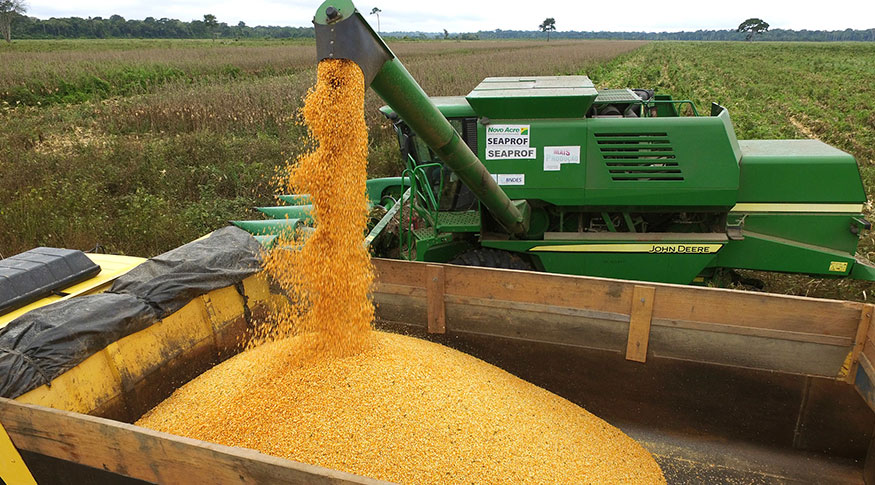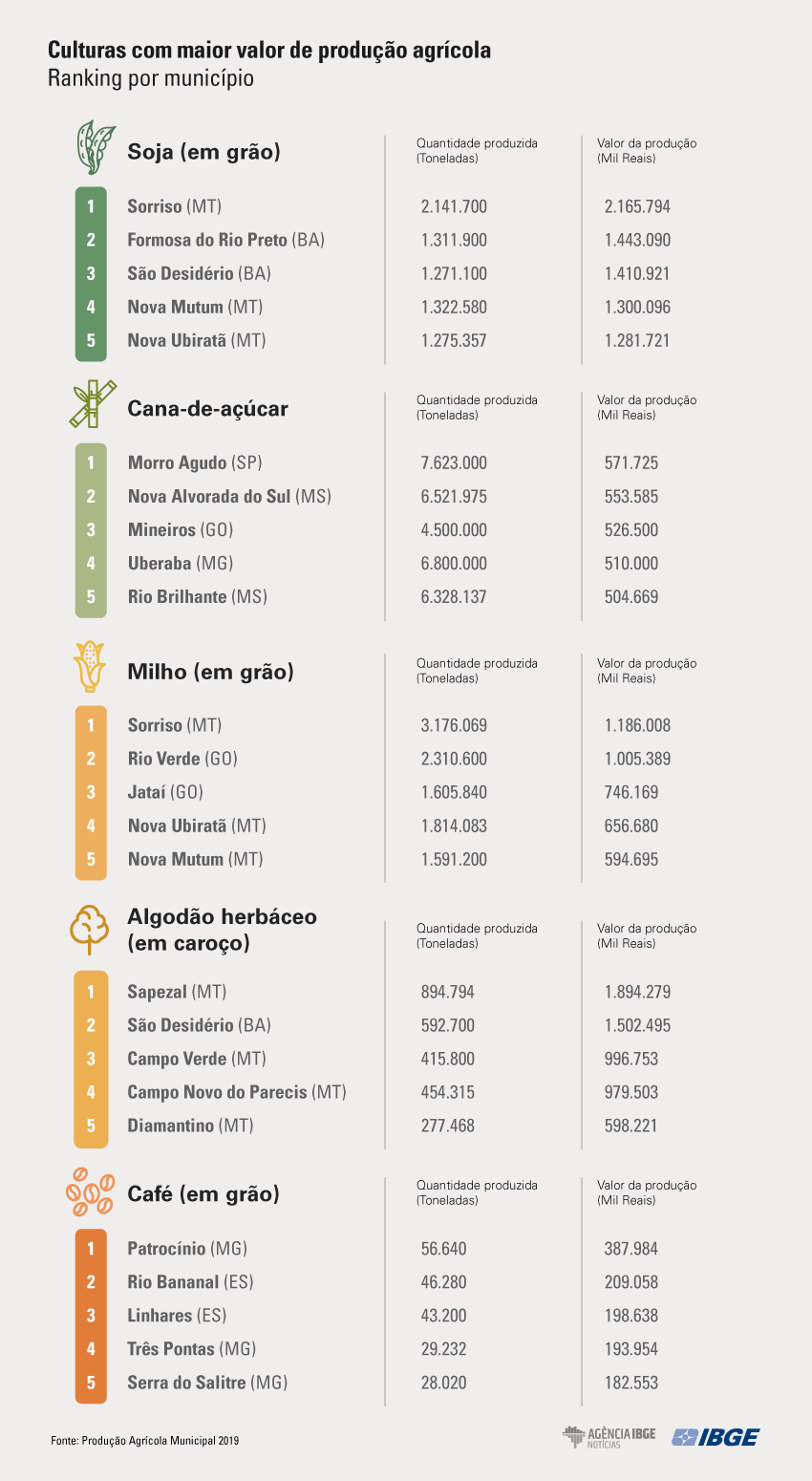PAM
Value of agricultural production reaches R$361 billion in 2019 and hits new record
October 01, 2020 10h00 AM | Last Updated: October 07, 2020 05h02 AM
Highlights
- R$ 361 billion was the value of agricultural production for the main Brazilian crops in 2019, a record in the survey time series.
- Corn, cotton and sugarcane were the main crops accounting for the rise of output value.
- Soybean, despite the 1.8% decrease in value, still leads the ranking of national agricultural production.
- For the first time, corn surpassed the figure of 100 million metric tons.
- The value of production of sugarcane increased by 5.3% against the 2018 figure.
- Planted area increased by 3.3% from the previous year and reached 81.2 million hectares, whereas harvested area grew by 3.5%, and reached 80.6 million hectares.
- Soybean was the main product in four of the five Major Regions. The exception was the Southeast, where production of sugarcane stood out.
- Sorriso, in Mato Grosso, had the biggest municipal value of agricultural production.

The value of production of the main Brazilian crops reached R$361 billion in 2019, and surpassed by 5.1% the record of the previous year, R$343.5 billion. Corn, cotton and sugarcane were the main products accounting for that increase. Soybean, despite the retraction of 1.8% in 2019, amounted to R$125.6 billion in the year and remained as number one in the ranking of national value of agricultural production. Data comes from the Municipal Agricultural Survey (PAM), released today (1) by the IBGE.
“It has been three years since climate conditions have favors agricultural production in the country. Drought-related problems were scarce and did not jeopardize production”, Winicius Wagner, survey supervisor, explains. The favorable climate and bigger investments in inputs and technology, and also the expansion of planted area, according to the researcher, led to higher average yield.
“That has caused us to hit subsequent records. We observed positive value of production figures in the last decade. Although there was slight retraction in 2017 due to the price of corn and other commodities due to a great offer from the market, since that year was marked by a super harvest”.
Besides soybean, the main crops in terms of value of national agricultural production were sugarcane (15.2%), corn (13.2%), coffee (4.9%) and upland cotton (4.4%). The amount produced also hit a record figure and surpassed the super harvest of 2017: the production of cereals, legumes and oilseeds amounted to 243.3 million metric tons, with an increase of 6.8% against 2018 and 1.9% against 2017.

A highlight in terms of value of production and amount, corn reached 101.1 million metric tons, with an increase of 22.8% against 2018, a year when producing areas faced climate problems. “That was the first time corn surpassed the figure of 100 million metric tons. Value of production also recorded the significant increase of 26.3%, and reached R$ 47.6 billion,” Mr. Wagner says. As a result, the share of corn in total value of production increased against the previous month, when it was 11%.
“The exported volume of corn hit a record, with 42.8 million metric tons, an increase of 86.2% from 2018. Among the factors accounting for that increase are the record harvest, the increase of world consumption and currency exchange. With the devaluation of real against dollar, we see that, since 2019, the exports of national products has been favored,” the researcher explains.
Soybean, the main export product in the country, accounted for 34.8% of the value of agricultural production in 2019. Although harvested area increased by 3.2%, that crop recorded a decrease of 3.1% in the generated volume. According to Mr. Wagner, climate-related factors damaged the final phase of the cycle in the main producing states.
“Throughout 2018 and January 2019, there was a dry period in an important producing area between the states of Paraná, Mato Grosso do Sul and São Paulo, which ended up affecting soybean yield. That caused several municipalities to record a decrease of average yield in this crop,” the survey supervisor says.
He explains that, in spite of the decrease in the amount of soybean produced, the 2019 harvest cannot be considered bad, given the high basis for comparison. “So, despite the decrease in the amount [of soybean] produced was the third biggest one in the time series investigated by the IBGE.”
Sugarcane, one of the main agricultural products in the country, increased by 5.3% in value of production and made up for the decrease registered in the previous year. Harvested area grew by 0.7% and output increased by 0.8% in one year. According to Winicius, due to the rise of gasoline prices, biofuel became more competitive and there was a record production of ethanol. That caused the production of sugarcane for ethanol production to increase in 2019.
“Approximately two thirds of the sugarcane production were used for the production of ethanol. The excessive supply of sugar in the foreign Market caused 2019 to see a decrease of 15.8% in exports. Even so, sugar production increased once more. But ethanol recorded an even higher increase.”
Harvested are reaches 80.6 million hectares
Planted area reached 81.2 million hectares in 2019, with na increase of 3.3% against the previous year. Increases in crop areas of corn (1.2 million hectares) and soybean (1.1 million hectares) accounted for the biggest contributions to that increase.
Considering harvested area, there was an increase 3.5% against 2018, amounting to 80.6 million hectares.
“When observing the history of harvested area, there has been significant increase in the last decade. That shows agricultural frontiers remain in expansion in the country, mainly in the Central West and also in Matopiba”, Winicius says, as he makes a reference to the region formed by Maranhão, Tocantins, Piauí and Bahia.
Central West reaches value of production of R$107.9 billion
Soybean was the main crop in four of the five Major Regions. In the Central West, the main producing region of that grain, total value of production surpassed the figure of 2018 by 12.2% and reached R$ 107.9 billion. Mato Grosso alone generated R$ 58.4 billion, due to soybean crops. Its production was also a highlight in the Northeast, led by the area of Matopiba. In the North, soybean has its crop expanded in Pará, which generated the biggest value of production in the Major Region, and in Rondônia.
Value of production in the South was R$ 91.6 billion, and there was an increase of 1.7% against 2018. Besides soybean, corn, rice, tobacco and wheat stood out. Soybean was the main product in all the Major Regions, except for the Southeast. The region generated R$97.6 billion in value of production. That is an increase of 2.1% against the previous year.
Mato Grosso is a highlight in Brazilian agricultural production
Sorriso, in Mato Grosso, is the Brazilian municipality with the highest value of agricultural production. A highlight in the production of soybean and corn, it had an overall value of production of R$ 3.9 billion and was, alone, responsible for 1.1% of the national overall. Besides Sorriso, 21 municipalities in Mato Grosso are in the ranking of biggest output in 2019. Together, they generated R$ 37.1 billion. Goiás, Bahia and Mato Grosso do Sul, had six municipalities each.

Other highlights in soybean production were the municipalities of Formosa do Rio Preto and São Desidério, in Bahia. In the previous year, São Desidério was the producing city with the biggest value of production in Brazil.
Morro Agudo, in São Paulo, was a highlight in the production of sugarcane. The planting of this crop generated, in the municipality, a production value of R$ 571.7 million. Nova Alvorada do Sul, in Mato Grosso do Sul, and Mineiros, in Goiás, are also among the cities which generated the highest production value from that crop.
Coffee, which was previously the main export product in the country, is a highlight in Minas Gerais. Despite the decrease of 21.4% in production volume, the state was responsible for 70.6% of all the arabica coffee in Brazil and reached 1.5 million metric tons. Patrocínio, a city in the interior of Minas Gerais, led the ranking of coffee bean production, with R$ 387.9 million, being followed by Rio Bananal and Linhares, both in Espírito Santo.



















